History of the Bridgnorth War Memorial
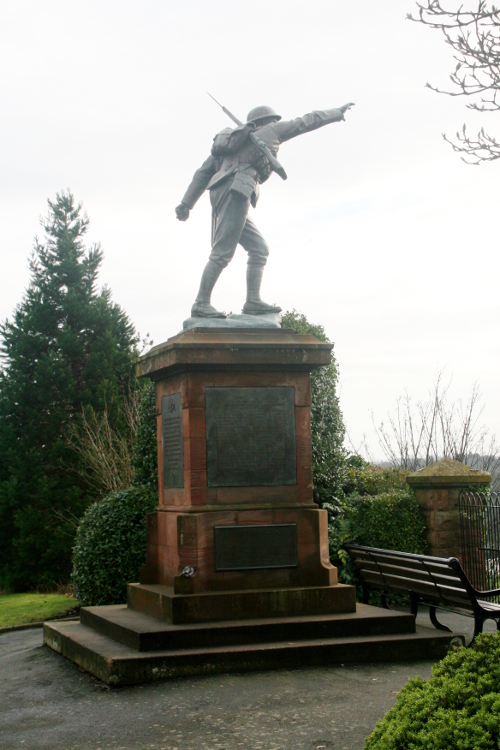
Bridgnorth's war memorial is dramatic on at least two counts: its location and its subject. The memorial occupies a prominent site in the Castle Gardens - at the cliff's edge, facing out into the void. The plinth is topped by the figure of a soldier in the battle dress of the Shropshire Light Infantry. He carries a rifle over his shoulder and has his arm stretched out as if he has just thrown a hand grenade.

The sculptor was Adrian Jones, a Shropshire artist born in Ludlow. After serving as a veterinary officer in the Royal Horse Artillery, Jones became a full-time sculptor. He was responsible for several prominent national pieces including the sculpture Peace descending on the Quadriga of War which stands on top of the Wellington Arch in Hyde Park as a memorial to King Edward VII.
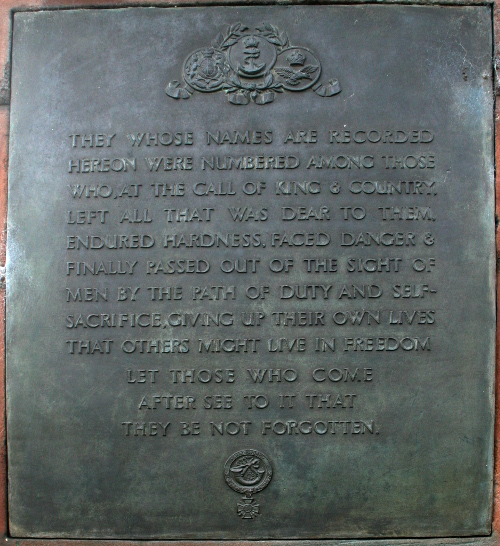
The memorial bears the inscription:
Erected in honour of the men of Bridgnorth who served their country in the Great War 1914-1919 and to the ever glorious memory of those who fell. Also to the memory of those who fell in the Second World War 1939-1945.
They whose names are recorded hereon were numbered among those who, at the call of King and Country, left all that was dear to them, endured hardness, faced danger & finally passed out of the sight of men by the path of duty and self-sacrifice, giving up their own lives that others might live in freedom. Let those who come after see to it that they be not forgotten.
The names and ranks of 143 persons who died in the Great War and 48 who died in the Second World War are listed. The two panels of names from the Great War are reproduced on a separate page of this website with links to information about the soldiers named. The two panels of names from World War II are shown here:
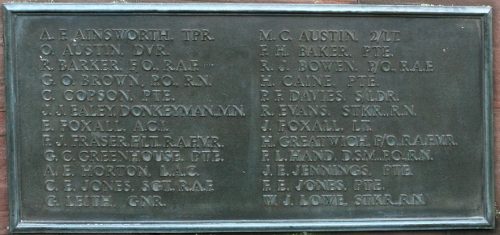
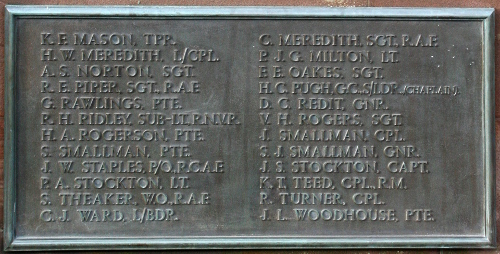
Planning the Memorial
Meetings began in March 1919 to discuss the erection of a war memorial. Various suggestions were made: a statue bearing the names of the fallen; a large monument on Pan-Pudding Hill; improvements to the hospital and health care in the town; chimes for the Town Hall; a Memorial Hall; oak panelling for the Town Hall.
The statue finally decided on, a site had to be decided. The initial suggestion was the High Street, by Lloyds Bank - but everyone seems to have had their own idea. The site of the existing Whitmore Monument, the top of the North Gate, outside the Post Office. The final site in Castle Gardens seems to have been a late compromise.
The next question was who should be named on the memorial? There was general agreement that only the fallen should be on the memorial itself but that a written Roll of Honour listing all those who had answered the call to arms should be prepared and preserved by the Town Council. 'The Men of Bridgnorth' in whose honour the memorial was to be erected would be defined as 'the men of the parishes of St Mary Magdalene and St Leonards'.
The actual list of names to be inscribed on the monument appears to have been based on that maintained by the Bridgnorth Journal throughout the war. During the years before conscription, the paper had printed details of all those joining up. Full lists were printed at the end of 1914 and 1915 listing all those who had gone to war, street by street. A final list of The Fallen was printed in the issue of 14th August, 1920; with a few late additions, these are the names which appear on the memorial.
The Unveiling
The Bridgnorth War Memorial was unveiled at a public ceremony on Thursday, 9th March, 1922. The guest of honour was
Private Eli Jones, a native of Bridgnorth, who served with the Coldstream Guards, and who had the misfortune to lose both his legs, a double amputation each time. [Those present] were glad to see him with them that day after all he had gone through. He typified the great pain and suffering which had been borne by so many of their brave men.'
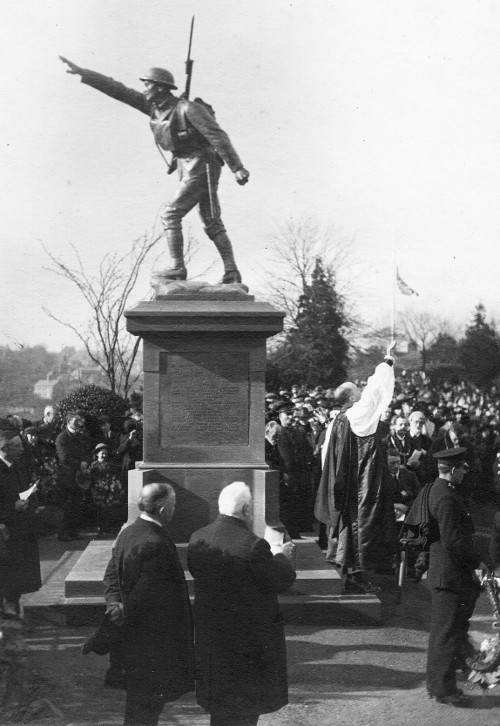
Captain Adrian Jones [the sculptor] then handed the cord to Private Eli Jones, who was seated in his wheelchair, close to the Memorial, and on pulling this it released the Union Jack that had enfolded the figure.
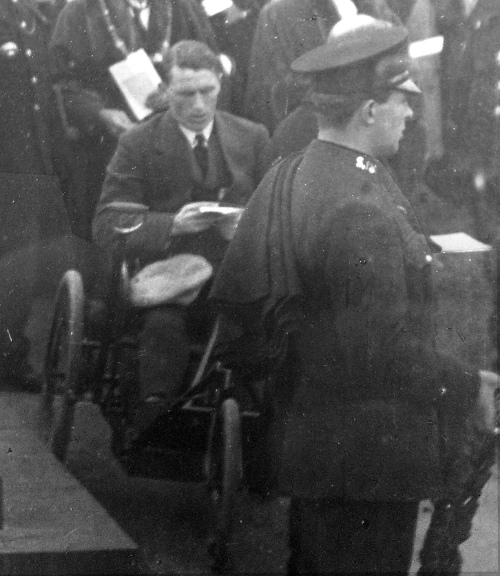
The rifle and bayonet have proved tempting as trophies to later generations of Bridgnorth youth. They have needed replacing on several occasions.
Private Eli Jones
from an article printed in 'The Journal of the Shropshire Family History Society', March, 2014
The reference to Private Jones unveiling the memorial intrigued me. I thought I would see what I could find out about him. Half-an-hour's research online served to expand Eli's story - which I share with you here both for its intrinsic interest and as an example of what can now be discovered from the comfort of one's own desk.
My starting point was the information contained in the report of the unveiling: that Private Jones was a native of Bridgnorth who had served with the Coldstream Guards and lost both his legs. My first stop was Ancestry.co.uk where the 1911 census shows Eli living with his mother in Listley Street, Bridgnorth and working in a fish and poultry shop. His Attestation Papers show that he enlisted on the 11th August, 1914, a few days after war was declared. He was posted to the 1st Battalion Coldstream Guards, part of the Expeditionary Force in France, on 26th November, 1914. Less than a month later he was injured: 'G[un] S[hot] wounds both legs and back at La Bassee 24/12/14'.
Turning to Google we find that there had been a battle at La Bassee the month before Eli was injured there. Part of the so-called Race to the Sea, it left both sides digging themselves into the trenches which were to feature so terribly for the remainder of the war.
Now to the National Archives where, for the princely sum of £3.36 I was able to purchase a digital copy of the war diary of the 1st Bn., Coldstream Guards. This shows that when Eli arrived in France the Battalion had already been involved in action. It was behind the lines undergoing a period of reforming and training.
Eli was probably part of the draft of 215 soldiers who arrived just in time to be present when the King inspected the Battalion on the 3rd of December. On the 19th, after a period of training at Strazeele, Eli was appointed Lance Corporal.
On the 20th, the Batallion marched to Givenchy with orders to retake trenches which had been captured by the Germans the previous day. After two days fighting, they were relieved on the 22nd and billeted at Cambrin in 'farm buildings round a dirty midden'.
1st Bn. remained in reserve during the 24th, the day on which Eli Jones is recorded as receiving his wounds. No casualties are recorded in the war diary for that day so Eli was possibly one of the 185 other ranks injured or missing in the fighting of the 21st - 22nd. His wounds must have left him unable to move, so it is possible that he was one of those initially posted missing.
Eli arrived back in England on New Year's Day, 1915. The same day his promotion to Lance Corporal was officially posted. He was discharged from the army on the 16th August.
Eli's short and bitter experience as a soldier didn't weaken his resolve to 'do his bit' as the following from the Aberdeen Journal of 7th April, 1916 shows:
One of the most remarkable of the double amputation cases concerns Lance-Corporal Eli Jones, of the Coldstream Guards. he had the misfortune to be badly wounded while fighting in France, and it was necessary to amputate both his legs above the knee joint. When he joined the army his height was 6 ft. 2 in. He was sent to Queen Mary's Auxiliary Hospital, where he was provided with artificial limbs, but for convenience sake they were made shorter than his original limbs, with the result that his stature has been shortened to 5 ft. 10 in. He is now employed by Messrs J. F. Rowley, the makers of the limbs, and every day, with the sole aid of a stick, he walks to the workshop at Roehampton House, London, and does excellent work for his maimed comrades in hospital by helping to make artificial legs for them.
As is too often the case, the paper didn't let the truth spoil a good story. Eli's attestation papers give his height on enlistment as 5' 9 3/8"!
This memorial has mostly been compiled from official sources. It would be good to be able to expand it with more personal material - memories, stories, photos, etc. If you have any suitable material or any corrections please contact Greg. For news of updates follow @BridgnorthHeros on Twitter.
